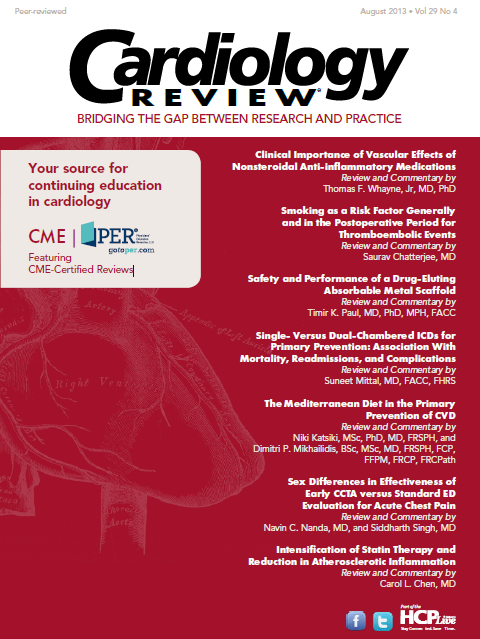Publication
Article
Cardiology Review® Online
Moving On From Summer
Debabrata Mukherjee, MD, MS, FACC
Editor-in-Chief
We are finally ready to move on from the scorching summer days to beautiful fall splendor in many parts of our country. Many of us are also looking forward to the football season and some of us are hoping that our home teams will do better this year. On a more serious note, this issue of Cardiology Review discusses many important articles and viewpoints that I am sure you will find quite useful.
Dr. Timir Paul reviews the safety and performance of the drug-eluting absorbable metal scaffold in patients with denovo coronary lesions and suggests that although we have a long way to go, when fully evolved, bioabsorbable stents will be as close as stents can come to human vessels. However, achieving balance between metal, polymer, and rate of degradation is definitely a challenge.
Dr. Saurav Chatterjee discusses smoking as a risk factor generally and in the postoperative period for thromboembolic events, and reports that that venous thromboembolism (VTE) incidence appears to be increased in current smokers, both in the absence of surgery and in the 12 weeks after surgery. This study identifies smoking as a possible risk factor for postoperative VTE events, and points to the need for future research attempting to incorporate smoking as a component of pre/perioperative risk scores for assessment of the likelihood of postoperative VTE events.
Dr. Thomas Whayne looks at the clinical importance of the vascular effects of nonsteroidal anti-inflammatory medications and reports that high doses of coxibs, diclofenac, and possibly ibuprofen are associated with a significant increase in CV risk, whereas high-dose naproxen has much less CV risk. He adds that a key concept to remember when using a coxib and all NSAIDs regarding CV and renovascular risk is the administration of the lowest effective dose for the shortest possible duration.
Drs. Niki Katsiki and Dimitri Mikhailidis assess the role of a Mediterranean diet in the primary prevention of cardiovascular diseases, and report beneficial effects of 2 Mediterranean diets (supplemented with olive oil or nuts) on CV risk reduction and particularly on stroke. However, they go on to state that further randomized clinical trials are needed to clarify the role of the Mediterranean diet on primary CV prevention, especially in non-Mediterranean countries where the Mediterranean diet may be harder to sustain.
Drs. Navin Nanda and Siddharth Singh comment on sex differences in the effectiveness of early cardiac computed tomographic angiography (CCTA) versus standard emergency department evaluation for acute chest pain, and infer that women who underwent CCTA had a shorter length of stay, decreased rate of admission to hospital, and lower cumulative dosage of radiation. The data from this study suggest that early CCTA may be a superior alternative to standard therapy in women presenting with symptoms of lowto intermediate-risk acute coronary syndrome. More evidence evaluating the diagnostic performance of CCTA in real-world scenarios is needed as it finds its true place in the armamentarium of cardiac imaging procedures.
Dr. Suneet Mittal discusses the impact of single- versus dual-chambered implantable cardioverter defibrillators (ICDs) for primary prevention on mortality, readmissions, and complications and reports that patients who received a dual-chamber device were much more likely to experience a mechanical complication as well as rehospitalization for heart failure. He opines that thoughtful consideration should be given to what is being implanted in any given patient. Dr. Carol Chen discusses role of intensification of statin therapy and reduction in atherosclerotic inflammation. She thinks that that Positron Emission Tomography-Computed Tomographic imaging (PET/CT) with 2-18F-fluoro-2-deoxy-D-glucose (FDG) as an imaging modality of atheroma inflammation may be potentially useful in drug development and determination of efficacy if clinical events can be predicted.
Finally, in our Clinical Forum section, Drs. Ragavendra Baliga, Sucheta Gosavi, and Michael Rich have a lively discussion on the interaction of statins and an exercise training program. I am sure you will enjoy the debate. Also, the insightful compilation of major studies presented at the American Diabetes Association 73rd Scientific Sessions by our managing editor, Ms Jackie Syrop, should keep you updated on the latest happenings in this field. She discusses several key articles in the news, namely the benefits of a lifestyle-based intervention program and intensive glycemic control, triple therapy for new-onset diabetes, and the cardiovascular effects of metformin versus rosiglitazone.
I hope that you will find these commentaries to be valuable and enjoyable. I encourage you to share your insights, thoughts, and personal experiences on the topics touched upon in this issue, and I would love to hear feedback on how we can make this journal even better. My goal continues to be to make you look forward to each issue of Cardiology Review — online and on the iPad.
Debabrata Mukherjee
Editor-in-Chief






